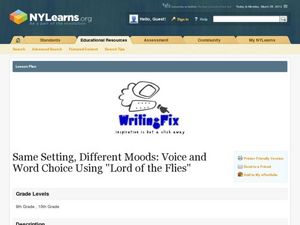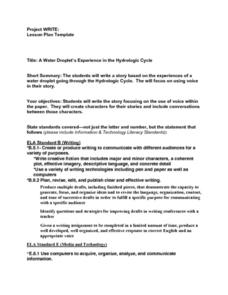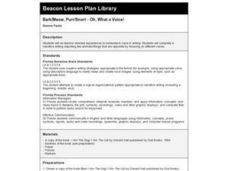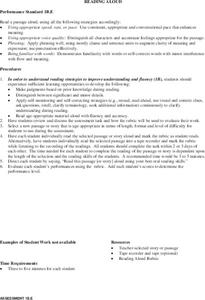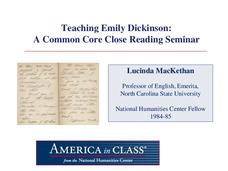Do2Learn
Tone of Voice and Volume Control
What level of voice is most appropriate for the classroom? Develop volume control in your learners with ASD with an activity that lets them know when they are using appropriate and inappropriate voice level.
Curated OER
Same Setting, Different Moods: Voice and Word Choice Using Lord of the Flies
Whether it's dark, delightful, or somber, set the mood with William Golding's Lord of the Flies. High-schoolers practice descriptive writing by creating the appropriate mood for an original scene, starring one of the book's main characters.
Thoughtful Learning
Adjusting Your Writing Voice
"Yo, what's up?" "Nuttin!" While such a dialogue might be appropriate between friends, it would be ill-advised in more formal situations. A mini-lesson asks young writers to consider how to adjust the voice they use to bring their...
Curated OER
Style and Voice
Develop the writing skills of your high school class. Writers consider their personal style and voice, read selections by other authors, and then write pieces that challenge them to experiment with their own style.
Florida Alliance for Arts Education
Theatre Arts
What skills do storytellers employ to bring to life the characters and events in their tales? After listening to a recording of a Haitian folk tale, class members consider how tone of voice, pace, and gestures can be used to enliven a...
Curated OER
On the Road Again
Young scholars read to their peers from selected texts. As one person reads, the other person listens to his/her peer, noting tone and fluency. Afterward, they reflect on each other's reading. There is a guided reflection worksheet...
Curated OER
What's My Tone?
Students answer a question in the same tone of voice that you ask it in. In this tone lesson plan, students respond to the volume and expression of the teacher's voice.
Curated OER
When I Set My Hat at a Certain Angle: Trying on Zora Neale Hurston's Voice to Dress-up Prose
After reading and evaluating examples of prose nonfiction by Zora Neale Hurston and other authors, high schoolers write a personal reflective essay rich in figurative language. By incorporating this strategy, they utilize voice within...
Curated OER
Watch the Road Signs
What makes a good speaker? Upper elementary learners practice oral fluency by working with a partner to read nonfiction books. While reading, they practice using correct tone of voice, making eye contact, and speaking clearly.
University of North Carolina
Sciences
Science writing follows many of the same principles as writing in language arts, but some structural details differ. Individuals read an online science handout that covers how to write with precision, choose appropriate details, and use...
Curated OER
Whose Voice Do I Hear?
Fifth graders examine the power of voice in writing by completing a story using words following a particular voice. They take simple nursery rhymes, then attempt to put their own voice to a revised version. An interesting lesson on writing!
Curated OER
Rubric for Research Papers
This rubric is decent, but it doesn't provide a point allotment for each category. Use this as an outline to create a more comprehensive assessment for your writers' research papers.
Curated OER
A Water Droplet's Experience in the Hydrologic Cycle
Students write a story from the perspective of a water droplet on a journey through the water cycle. They use the 6+1 Traits writing method to focus on voice in the writing as they create characters that their water droplet has...
Curated OER
Choosing the Correct Voice
In this writing voice worksheet, students complete three activities that help them understand and use the correct writing voice in formal papers.
Scholastic
Tell Us a Tale: Teaching Students to Be Storytellers
Encourage scholars to retell their favorite short story or folktale, adding personal details to make it their own. After reading their book of choice several times, story tellers retell a tale verbally to their classmates.
Curated OER
MTV's Poetry
Learners use several strategies in poetry to convey tone and speaker. In this language arts lesson plan, students read and build vocabulary as they gain a larger understanding of how to write poetry. Learners then work in groups in order...
Curated OER
What Kind of Ladybug Are You?
As a class, read different sentences prepared by the teacher, identifying the punctuation that is needed for the appropriate expression. In small groups, have each child assume the role of one or more character in The Grouchy Ladybug by...
Curated OER
Bark, Meow, Purr, Snort - Oh, What a Voice!
Students brainstorm differences between dogs and cats. They discuss the elements that make a story effective and write a story with a beginning, middle and end in the voice of a cat or dog.
Curated OER
Say What? (A Murder Mystery)
Students practice their performance, expression, and logical thinking skills by asking questions and speaking in correct tones. They attempt to meet IEP requirements in these areas by presenting murder mystery clues using the appropriate...
Curated OER
We All Need Speed Limits
Students consider fluency and speed of reading. In this speed limits lesson, students discuss the importance of speed when reading and how the rate affects comprehension and listening skills. Teacher models think aloud as a strategy.
Curated OER
What's that Mammal?
Learning by example is always effective if it's paired with independent practice opportunities! Model good reading practices for your class. Learners listen to the teacher model examples of reading with voice, expression, and tone...
Curated OER
Reading Aloud
Reading aloud is a great way to engage learners in pacing and pronunciation! They practice using voice, pitch and intonation correctly. The teacher introduces the lesson plan by example, correctly stressing punctuation and using...
Curated OER
Hoops! There It Is!
Fifth graders view and discuss the use of voice in writing through the in-your-face, aggressive, powerful messages of the Nike advertisements and the book Hoops as examples of the intensity words can have and how voice is expressed. A...
National Humanities Center
Teaching Emily Dickinson: A Common Core Close Reading Seminar
Three of Emily Dickinson's poems, "I like to see it," "Because I could not stop for Death," and "We grow accustomed to the Dark," provide instructors with an opportunity to model for class members how to use close reading strategies to...



